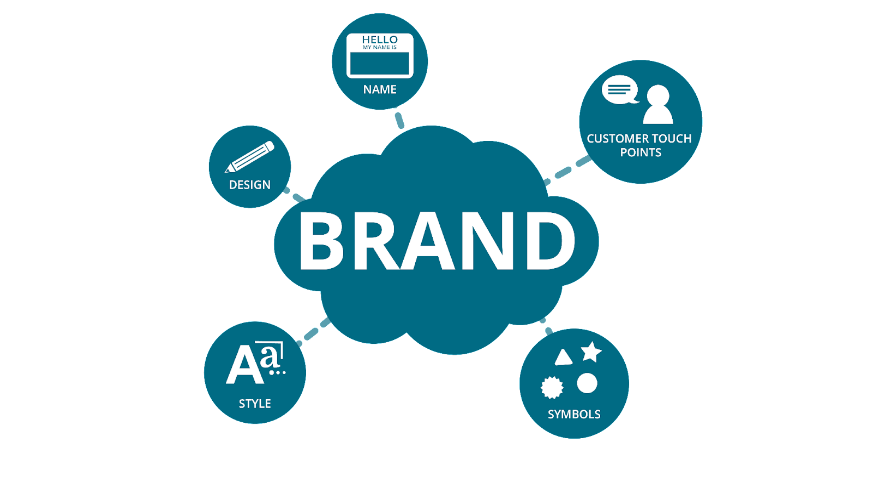12.1 Elements and Benefits of Branding
What Is a Brand?
Brands are interesting, powerful concoctions of the marketplace that create tremendous value for organizations and for individuals. Because brands serve several functions, we can define the term “brand” in the following ways:
- A brand is an identifier: a name, sign, symbol, design, term, or some combination of these things that identifies an offering and helps simplify choice for the consumer.
- A brand is a promise: the promise of what a company or offering will provide to the people who interact with it.
- A brand is an asset: a reputation in the marketplace that can drive price premiums and customer preference for goods from a particular provider.
- A brand is a set of perceptions: the sum total of everything individuals believe, think, see, know, feel, hear, and experience about a product, service, or organization.
- A brand is “mind share“: the unique position a company or offering holds in the customer’s mind, based on their past experiences and what they expect in the future.
A brand consists of all the features that distinguish the goods and services of one seller from another: name, term, design, style, symbols, customer touch points, etc. Together, all elements of the brand work as a psychological trigger or stimulus that causes an association to all other thoughts one has had about this brand.
Brands are a combination of tangible and intangible elements, such as the following:
- Visual design elements (i.e., logo, colour, typography, images, tagline, packaging, etc.)
- Distinctive product features (i.e., quality, design sensibility, personality, etc.)
- Intangible aspects of customers’ experience with a product or company (i.e., reputation, customer experience, etc.)
Branding–the act of creating or building a brand–may take place at multiple levels: company brands, individual product brands, or branded product lines. Any entity that works to build consumer loyalty can also be considered a brand, such as celebrities (e.g., Lady Gaga), events (e.g., Susan G. Komen Race for the Cure), and places (e.g., Las Vegas).
Brands Create Market Perceptions
A successful brand is much more than just a name or logo. As suggested in one of the definitions above, a brand is the sum of perceptions about a company or product in the minds of consumers. Effective brand building can create and sustain a strong, positive, and lasting impression that is difficult to displace. Brands provide external cues to taste, design, performance, quality, value, or other desired attributes if they are developed and managed properly. Brands convey positive or negative messages about a company, product, or service. Brand perceptions are a direct result of past advertising, promotion, product reputation, and customer experience.
A brand can convey multiple levels of meaning, including the following:

Photo by Mikes-Photography, Pixabay License
- Attributes: specific product features. The Mercedes-Benz brand, for example, suggests expensive, well-built, well-engineered, durable vehicles.
- Benefits: attributes translate into functional and emotional benefits. Mercedes automobiles suggest prestige, luxury, wealth, reliability, self-esteem.
- Values: company values and operational principles. The Mercedes brand evokes company values around excellence, high performance, power.
- Culture: cultural elements of the company and brand. Mercedes represents German precision, discipline, efficiency, quality.
- Personality: strong brands often project a distinctive personality. The Mercedes brand personality combines luxury and efficiency, precision and prestige.
- User: brands may suggest the types of consumers who buy and use the product. Mercedes drivers might be perceived and classified differently than, for example, the drivers of Cadillacs, Corvettes, or BMWs.
Brands Create an Experience
Effective branding encompasses everything that shapes the perception of a company or product in the minds of customers. Names, logos, brand marks, trade characters, and trademarks are commonly associated with brand, but these are just part of the picture. Branding also addresses virtually every aspect of a customer’s experience with a company or product: visual design, quality, distinctiveness, purchasing experience, customer service, and so forth. Branding requires a deep knowledge of customers and how they experience the company or product. Brand-building requires long-term investment in communicating about and delivering the unique value embodied in a company’s “brand,” but this effort can bring long-term rewards.
In consumer and business-to-business markets, branding can influence whether consumers will buy the product and how much they are willing to pay. Branding can also help in new product introduction by creating meaning, market perceptions, and differentiation where nothing existed previously. When companies introduce a new product using an existing brand name (a brand extension or a branded product line), they can build on consumers’ positive perceptions of the established brand to create greater receptivity for the new offering.
Brands Create Value
Brands create value for consumers and organizations in a variety of ways.
Value of Branding for the Consumer
Brands help simplify consumer choices. Brands help create trust, so that a person knows what to expect from a branded company, product, or service. Effective branding enables the consumer to easily identify a desirable company or product because the features and benefits have been communicated effectively. Positive, well-established brand associations increase the likelihood that consumers will select, purchase, and consume the product. Dunkin’ Donuts, for example, has an established logo and imagery familiar to many U.S. consumers. The vivid colours and image of a “DD” cup are easily recognized and distinguished from competitors, and many associate this brand with tasty donuts, good coffee, and great prices.
Value of Branding for Product and Service Providers
For companies and other organizations that produce goods, branding helps create loyalty. It decreases the risk of losing market share to the competition by establishing a competitive advantage customers can count on. Strong brands often command premium pricing from consumers who are willing to pay more for a product they know, trust, and perceive as offering good value. Branding can be a great vehicle for effectively reaching target audiences and positioning a company relative to the competition. Working in conjunction with positioning, brand is the ultimate touchstone to guide choices around messaging, visual design, packaging, marketing, communications, and product strategy.


Photo by JerryUnderscore under Pixabay License
For example, Starbucks’ loyal fan base values and pays premium prices for its coffee. Starbucks’ choices about beverage products, neighbourhood shops, the buying experience, and corporate social responsibility all help build the Starbucks brand and communicate its value to a global customer base.
Value of Branding for the Retailer
Retailers such as Target, Safeway, and Walmart create brands of their own to create a loyal base of customers. Branding enables these retailers to differentiate themselves from one another and build customer loyalty around the unique experiences they provide. Retailer brand building may focus around the in-store or online shopping environment, product selection, prices, convenience, personal service, customer promotions, product display, etc.
Retailers also benefit from carrying the branded products customers want. Brand-marketing support from retailers or manufacturers can help attract more customers (ideally ones who normally don’t frequent an establishment). For example, a customer who truly values organic brands might decide to visit a CVS store to shop for organic household cleaners that are safe to use around babies. This customer might have learned that a company called BabyGanics, which brands itself as making “safe, effective, natural household solutions,” was available at this particular retailer.
Principles of Marketing (Lumen) Module 9: Branding edited by LibreTexts, based on Introduction to Business by Boundless, is licensed under a Creative Commons Attribution-ShareAlike 4.0 International License.

